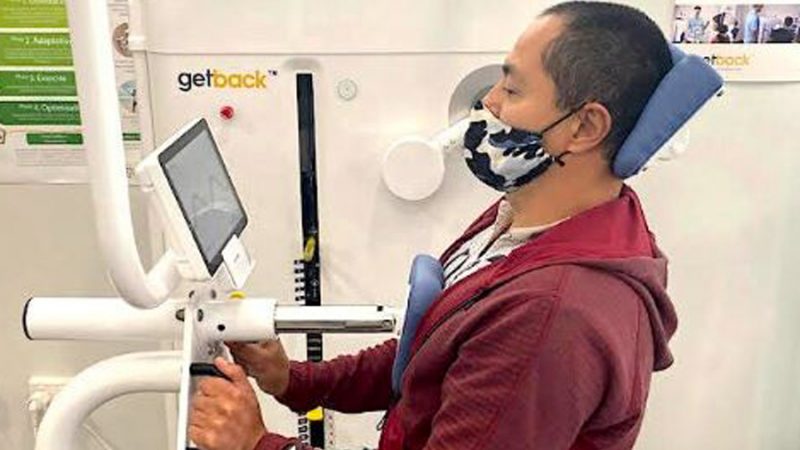1. Optimized Biomechanics
What is critical in the design of a back extension device? Biomechanics is the most important element. A well-designed back exercise prevents any harmful movements, is gentle on the joints but highly fatiguing for the muscles, and can be easily fine-tuned for each individual. Several studies have shown that movement can act as medicine for painful joints. The spine, however, is a very complex structure involving vertebrae, discs, ligaments, dynamically functioning rotator and intervertebral muscles as well as large, mostly statically functioning supporting muscles.
When back pain and loss of coordination are added to the equation, it is extremely difficult to start exercise therapy in a controlled manner. Medical back extension devices are required to isolate the target area and provide total control in the movement and loading.
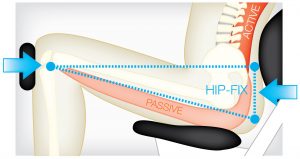
2. Isolated training
Why is isolated training important in back pain patients? Many patients who suffer from back pain have compensatory behavior. This means that other muscle groups in the body take over the function of the muscle groups in the back. The activity in the back is avoided because of the pain. As a result, the strength and mobility of the muscles in the back decrease and the muscle groups that take over the activity are overloaded. In the case of prolonged compensation, pain complaints arise elsewhere in the body. This means it is necessary to isolate training for the muscles in the back.
A medical back extension device has been developed in such a way that the compensation of other muscle groups is kept to a minimum. In this example below, research has been done to understand the use of a medical back extension device for the lumbar thoracic extension of the spine. In this case, the erector spinae are highly activated compared to the hip extensors and back/hip flexors.
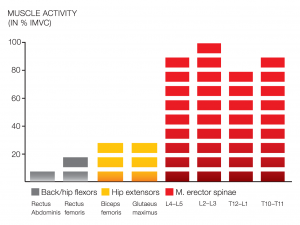 (The Spinal Muscular Profile, Achim Denner, Springer 1992)
(The Spinal Muscular Profile, Achim Denner, Springer 1992)
3. Correct loading

A medical back extension is equipped with a monitor that maps time and speed of exercise via intelligent software. A compliance score at the end of the exercise indicates the quality of the exercise. The algorithm adjusts the program where necessary.
This kind of result would not be possible with a faulty loading control. In this specific case, there is a 97% compliance score and the range of motion is within the norms.
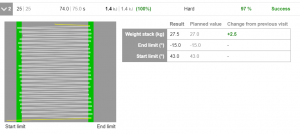
Practical benefits of correct loading by a medical back extension machine
- Patients feel that the movement is very gentle and smooth, with no jerks of peaks.
- Muscles are doing always the most amount of work possible on that level, regardless of the loading level
- Exercise is safe, even when the fatiguing effect is very high
- Movement is practically always pain-free, when the joint is supporting and the load is smooth
4. Safe training environment
When is back extension training safe? When the movement mobilizes the lumbar/thoracic spine in the sagittal plane activating the extensor muscles in a controlled manner with limited range of movement. It allows people with even severe and prolonged back pain and lack of coordination and strength to start mobilization and strengthening exercises with complete safety and minimal pain.
With an extensive test facility, the mobility and the isometric strength of the muscles around the spine can be accurately mapped. This creates a safe environment that guards that the patient does not select a training weight that is too high.
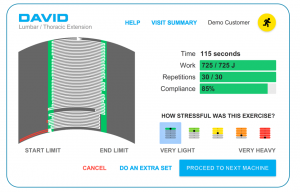
5. Ability to test and measure the spine
How should testing and measuring be done? The safest and most repeatable way to test the strength of muscles around the spine is to use isometric strength tests. The force is measured in Newton meters and compared to a validated normative values. The software system uses a program template to calculate the correct training weight within the patient’s mobility limits. If a strength test is too strenuous in this phase, it is a good idea to first use a mobility test to train the coordination and slowly increase the training weight from sc. safe values.
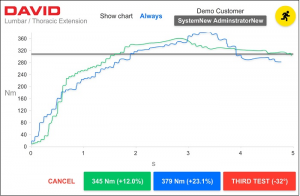
6. Digital Treatment protocol
How can a back-pain patient be treated? The overall goal of a successful treatment is that the experienced pain decreases and the quality of life improves. In order to achieve this goal, the active therapy must be progressive and in line with the individual’s ability to adapt to the changes. The treatment is always based on an individual assessment. The progression of the program follows the patient’s subjective evaluation of the experienced resistance and pain indicators. A default program for the back extension provides a safe start, which can be used in the early stages of rehabilitation. In the beginning, the range of motion is designed to be small and the loading light. The physical therapist is now able to monitor the progression and feedback of the patient and to adjust the program in real-time.

7. Program templates for back problems
How does treatment tracking work? Painful joints and tissue are the critical limiting factors in how much loading and range of motion can be used. This schematic picture shows how loading progression is controlled during the treatment in a back extension device. It is critical to always keep the loading under the aggravation threshold while at the same time aiming to cause adaptive changes in the muscles and tissue. In this example, pain tracking prompted a load decrease, until the situation stabilized.
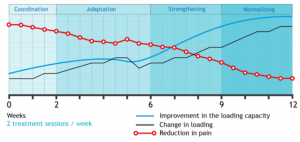
8. Patient experience
What can motivate a back-pain patient? All training variables are monitored and the system calculates instantly compliance percentage from correct speed, range of motion, and workload. This helps with patient motivation.
Monitoring patient and center level compliance is an important part of quality control. Educating patients based on objective data is important for patients to become owners of their own care process. Explaining what is going on with the patient’s back is an important factor to promote recovery.
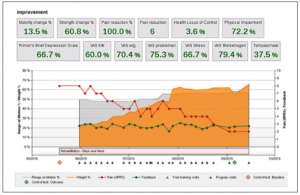
9. Data collection
What do data and an exercise device have in common? With high quality, comprehensive data, the medical back extension device is now moving to the next level in data analytics which utilizes Artificial Intelligence (AI). Using sophisticated machine learning algorithms and rapidly growing patient data, AI-engine optimizes the data collection procedure, finds subgroups of patients with similar treatment responses, predicts treatment outcomes, and optimizes treatment during different stages of the treatment period.
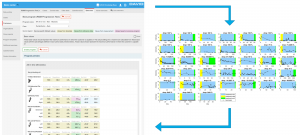
10. Clinic management
What does the future look like? Physiotherapy is very often provided as a one-to-one treatment, which means that an increase in patient volume will lead to an increase in costs. For this reason, physiotherapy is often not regarded by providers as profitable. It can also, in many cases, lead to a limit to the prescribed treatment time, which could be detrimental to the patient’s long-term results. With a smart back extension device as part of the total spine solution, it is possible to treat more than 1 on 1 without sacrificing treatment quality.
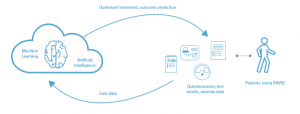
 English
English 






















